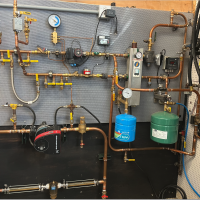Welcome! Here are the website rules, as well as some tips for using this forum.
Need to contact us? Visit https://heatinghelp.com/contact-us/.
Click here to Find a Contractor in your area.
If our community has helped you, please consider making a contribution to support this website. Thanks!
Best Of
Re: Big thank you to Peerless Boilers.
Things may be starting to turn around. They have been complaining about the lack new students coming into the trades for the last 15 years or so. At code update classes they said the average age of plumbers, pipefitters and electricians was 56 years old. And that was years ago. Probably a lot higher now.
But at my latest update this past weekend the instructor who also teaches in a trade school said that things are picking up and the school had 350-400 new students.
The pendulum swings.
But at my latest update this past weekend the instructor who also teaches in a trade school said that things are picking up and the school had 350-400 new students.
The pendulum swings.
Re: Big thank you to Peerless Boilers.
The General Society of Mechanics and Tradesmen is such a great group; love that old building.They are restoring the skylight.
On aside note, what are they doing to the library? It that a temporary deck for falling object protection from work being performed on roof?
Re: Taco's VT2218 Delta T circulator
SteveSan and JoeM, I used the Taco Customer Response System at tacocomfort.com and replacement has been shipped after providing details. Taco does respond on this issue. Thanks to Mario DelSignore for helping me with this.
 ncalhvac
ncalhvac
2
Re: Info on 1947 Jantrol gas conversion on 100 year old coal ARCO boiler.
Thanks for your feed back. Just replacing it for a new boiler. Got the contractor from this site. Not a thermocouple but a thermoswitch that would open unpredictably. It just made sure the pilot was lit. Boiler only had pressure relief vent, pressuretrol and that thermoswitch as safety. No rollout fuse, spill switch or low water cutoff. They lived dangerously back then.
1
Minnesota Right to Repair Law
https://pirg.org/articles/minnesota-passes-broadest-right-to-repair-measure-to-date/
Not the whole article, but here is the WMno57 condensed version:
Not the whole article, but here is the WMno57 condensed version:
When originally filed, the Minnesota legislation covered all electronic products except for cars and medical devices. As the bill moved forward, farm and construction equipment was also exempted, as were video game consoles and home energy storage systems.
The bill still covers everything else. For the first time, the Right to Repair extends to appliances, enterprise computing and commercial equipment (such as HVAC systems). In addition, the bill covers many of the products already included in New York’s first-in-the-nation consumer electronics Right to Repair bill.
The bill still covers everything else. For the first time, the Right to Repair extends to appliances, enterprise computing and commercial equipment (such as HVAC systems). In addition, the bill covers many of the products already included in New York’s first-in-the-nation consumer electronics Right to Repair bill.
 WMno57
WMno57
1
Re: Need help connecting new Honeywell Thermostat
Your instructions / tips resulted in a successful installation and a warm home!!
Thanks again & Merry Christmas
Thanks again & Merry Christmas
Re: Taco's VT2218 Delta T circulator
ncalhvac
I suggest you contact Taco tech support at 401-942-8000 for any questions. I’m confident they’ll be able to help you.
Re: Auto shutoff valves for hot water heater, or whole house?
What is the failure in those flood stop valves?
Assuming there are no leaks in the boiler system, you should be able to shut off the entire home without a problem.
A low water cut-off on the boiler could be added for extra protection. Although some of those have a questionable life expectancy also. Certainly do not want a boiler lock out while you are away
Assuming there are no leaks in the boiler system, you should be able to shut off the entire home without a problem.
A low water cut-off on the boiler could be added for extra protection. Although some of those have a questionable life expectancy also. Certainly do not want a boiler lock out while you are away
 hot_rod
hot_rod
1
Re: Big thank you to Peerless Boilers.
NYC needs steam men. Sounds like they are off to a good start
Re: Dan Holohan Retires After 36 Years of Writing Magazine Columns
I've still got that 1st book (1992) and I can say that you gave me the everlasting tools to be able to fix heating (and other building) systems, and I've been doing so ever since... One can't fix things unless they unlock how things are supposed to work to begin with, and you unlocked the mysteries that roam the insides of the lengths of pipe and boilers in our dwellings, both old and new. You taught us how to listen to the whispers that come from cast iron and vents... You shared the steamy stories told by tanks and valves... You've managed to build a lasting knowledge base, an online toolbox full of tales, stocked with many people from all over, both dead and alive. For these things, I thank you (and your family), for you have given all the "dead-men" a second life.

